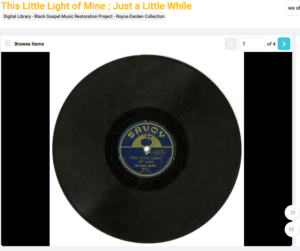The wave of high-profile police killings of Black Americans during the summer got a lot of people protesting across the country — and it got them singing in the process.

Baylor Professor Robert F. Darden’s passion is collecting and preserving historic black gospel music. (Photo/Baylor University)
“The act of singing, in and of itself, is an empowering event, said Robert Darden, a Baylor University professor and founder and director of its Black Gospel Music Restoration Project.
“When we sing in groups, studies show it creates endorphins, it creates community, and when you are surrounded by dogs and guns and redneck sheriff’s deputies, that’s exactly what you need.”
Demonstrations held since the May 2020 murder of George Floyd have included the singing and chanting of songs previously heard in the #MeToo, Civil Rights and labor movements, among others, Darden said.
“‘Freedom songs’ is one term for them, and they can include spirituals, old Gospel songs and even pop songs. ‘Lean on Me’ became a common song in protests after George Floyd was killed.”
Whether they are called “freedom songs” or “protest spirituals,” and whether they are modern or centuries old, the hymns usually are adapted to modern realities.
Whether they are called “freedom songs” or “protest spirituals,” and whether they are modern or centuries old, the hymns usually are adapted to modern realities. “The nature of a ‘freedom song’ is it is never static. The lyrics reflect who is singing it and the situation or movement at hand,” Darden said.
Shortly after Floyd’s killing by a Minneapolis police officer, Baylor asked Darden to compile a list of protest songs he felt were especially relevant to the ongoing protest movement.
“I’ve actually been doing these lists back to Ferguson,” he said of the 2014 police shooting of Michael Brown and the subsequent unrest that gripped that Missouri city. “I was putting lists together for Huffington Post and Christianity Today.”

(Image/Baylor Black Gospel Music Restoration Project)
His 2020 list included “Up Above My Head, I Hear Freedom in the Air.”
“This old spiritual became a favorite in the great singing protests of Albany, Ga., and quickly spread throughout the South,” Darden said in his online list.
Another was “We Shall Not Be Moved” as well as “Which Side Are You On?” which, Darden explained, were adopted by U.S. labor movements when African Americans were admitted in the 1930s and 1940s. “These two old union songs were quickly adopted and expanded by the Civil Rights Movement of the ’50s and ’60s.
“This Little Light of Mine” is a historic children’s tune that evolved into “one of the most popular and righteous of the freedom songs. It was easily adaptable to every situation and good for naming the names of your oppressors.”
Darden’s top pick was the iconic “We Shall Overcome.” It is, he said, “always sung standing, with arms crossed clasping the hands of those on either side. It is at its most powerful — then and now — when the lines ‘Black and white together’ are included.”
In light of the deaths that occurred this year, Darden said recently, he would add the hymn “Amen” to his list because he’s heard it sung in current protests. “People are adding to the lyrics specific to the place.”
Another is “Don’t Let Nobody Turn You Around,” which he said has multiple titles, varying lyrics and has been sung during recent protests in the United Kingdom and the U.S. “It’s adaptable to whatever setting.”
Such hymns have earned their staying power from being folksy and easy to remember — an important feature to those singing in picket lines or marching against armed police, Darden said. “You’re not going to have a hymnal with you” in those situations.
And singing them in a group helps build courage, he added.
“These songs get people fired up to face the horses and police dogs in places like Selma, Ala. These songs help you know who is on your side and who isn’t, and they help you when you need encouragement, and that courage is magnified when you have thousands of people singing with you.”


